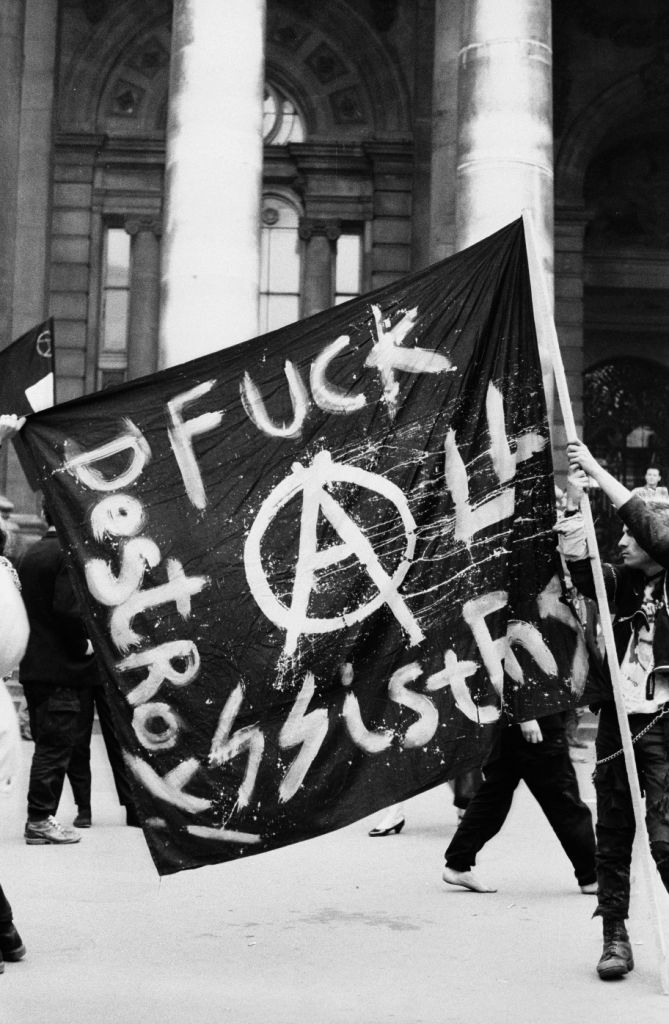
This is the second draft of a talk I will be giving to an Anarchist Seminar at Glasgow University’s Dumfries Campus on April 9th 2014.
I am posting it now so I can include feedback / comments in the final draft. I have written a lot about the punk side of anarcho-punk, but this is the first time I have written from the perspective of the anarcho side…
Thanks to Tony B for supplying the Autonomy Centre poster and Penguin for the KYPP bits and bobs. Thanks to Chris Low for supplying the Stop The City flyers.
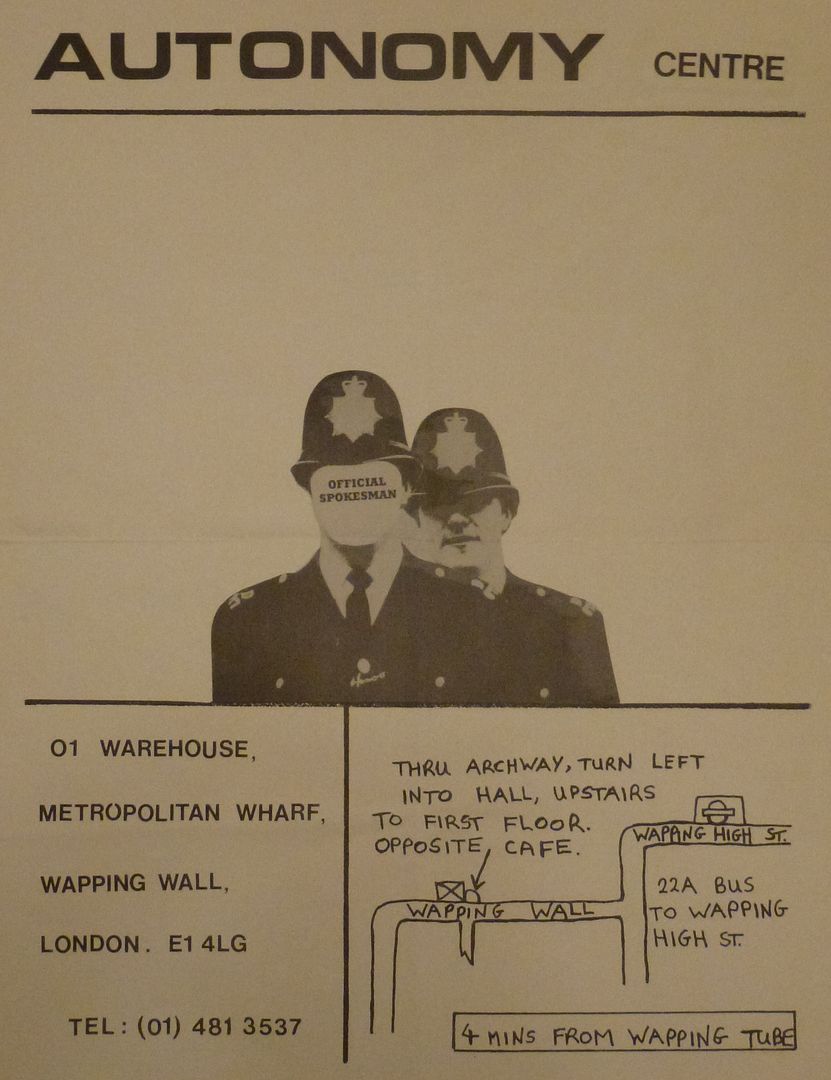
On 3rd January 1979, in the middle of the so-called ‘Winter of Discontent’ I arrived at the London Rubber Company’s east London factory to start a new job as a trainee draughtsman. I had started working for the company in one their factories in Gloucestershire in 1977. The year before, while I was briefly a student, I had joined an anarchist group at Stirling University and started buying Black Flag. I had also signed up to Stuart Christie’s Ceinfeugos Press paying £2 a month to receive copies of the books they published.
A few months after arriving in London I was invited to a Black Flag / Ceinfeugos readers meeting above a pub on the Kings Road. This turned out to be a support group meeting for the defendants in the Persons Unknown Anarchist Conspiracy Trial which was to begin in September, so as well as Stuart Christie and Albert Meltzer I met Iris Mills and Ronan B and I think Dave Morris of later McLibel Trial was also there.
Iris and Ronan were acquitted and after the acquittal, Ronan had the idea of setting up an anarchist social centre in London. To raise funds for this social centre, the notionally anarchist punk groups Crass and the Poison Girls were approached to make a benefit record for the centre which was released in 1980. As a result of this connection, at one of the planning meetings in early December 1979 I met a group of punks.
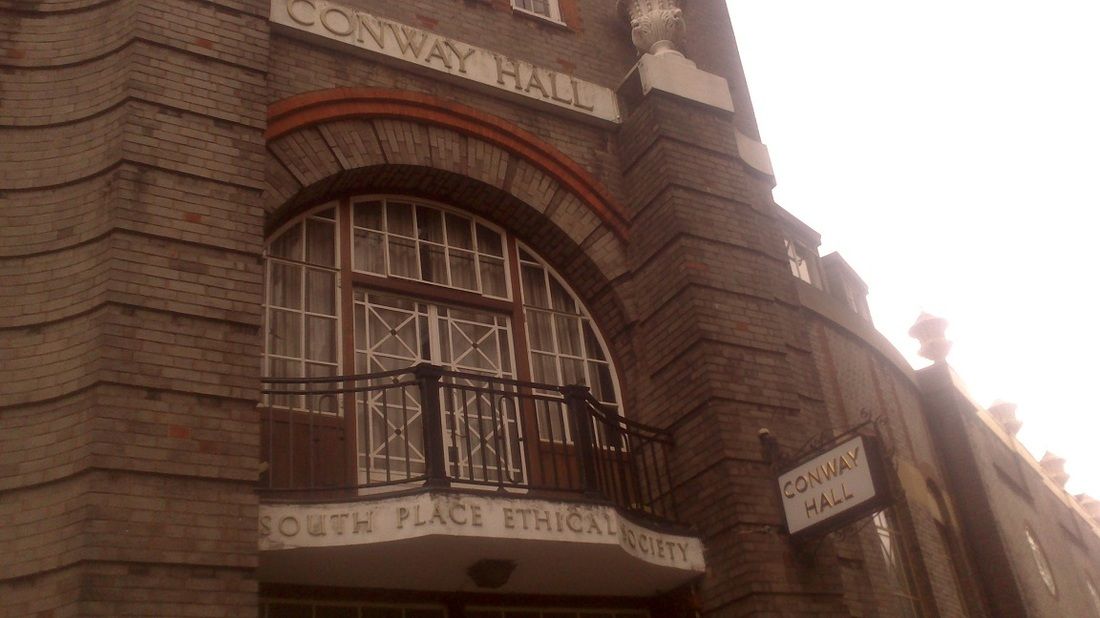
The meeting was held in the Conway Hall in Red Lion Square and after the meeting we all went to the nearest pub where I got into conversation with them and found that they produced a punk fanzine called ‘Kill Your Pet Puppy’. Tony Drayton of the Puppy Collective as they called themselves had started his first fanzine called ’Ripped and Torn’ back in 1976. This was a very well-known punk fanzine. We had a lengthy conversation and when I got back to my bedsit in Ilford I bashed out a letter to Tony inspired by our conversation.

At the next planning meeting in January, Tony gave me a copy of Kill Your Puppy number two which had my letter in it. I was impressed, as it was a very long letter!
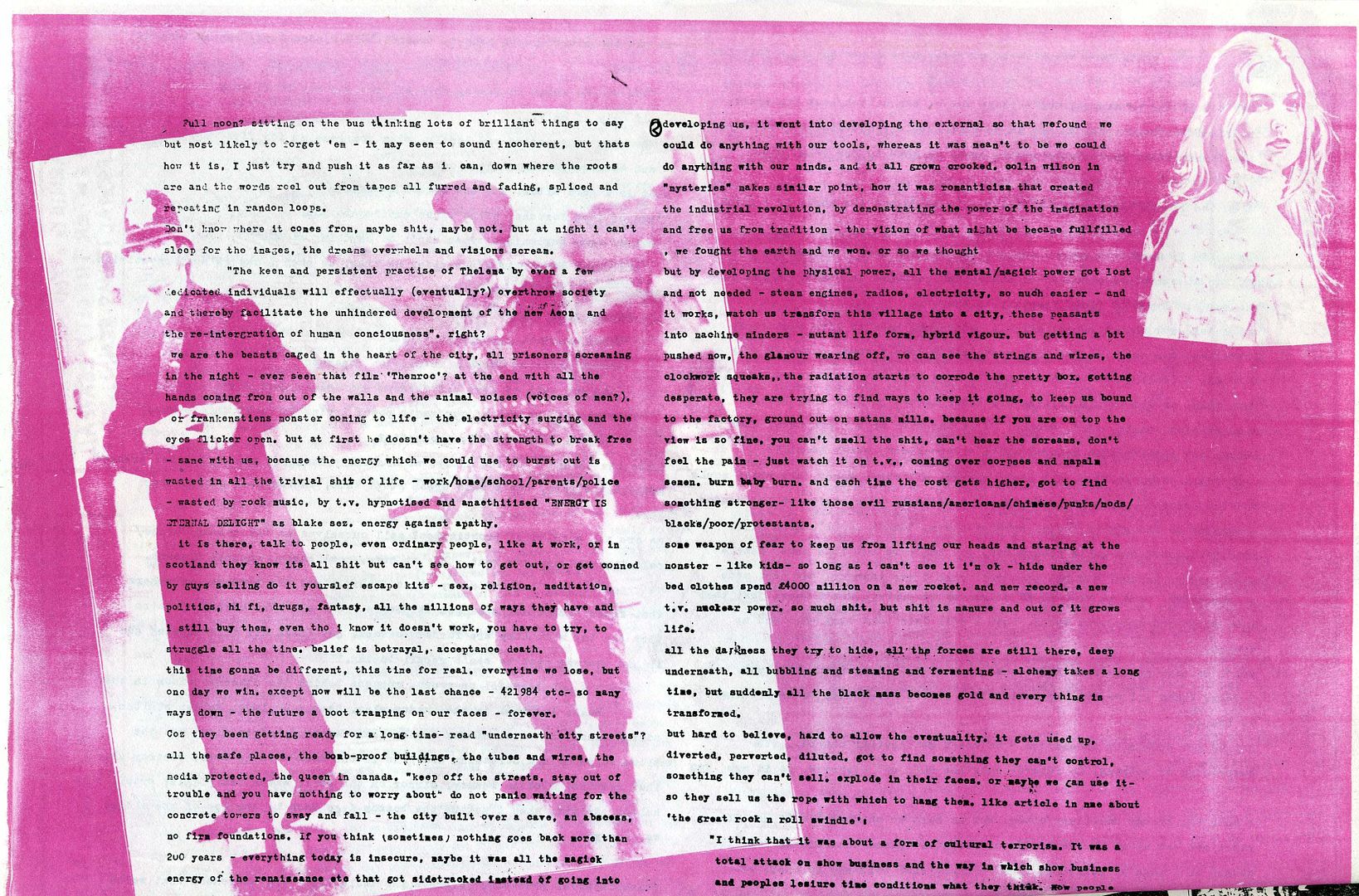
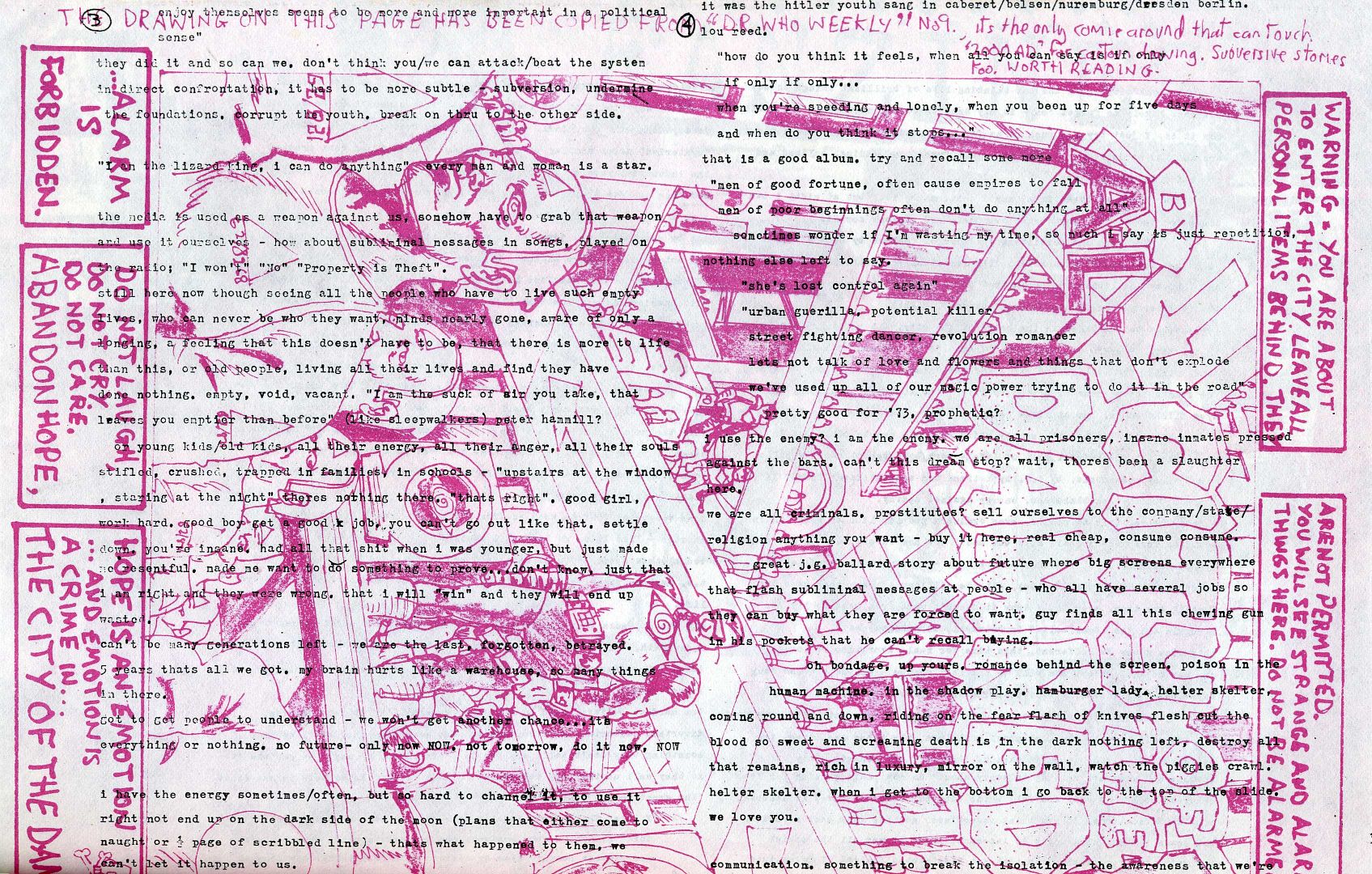
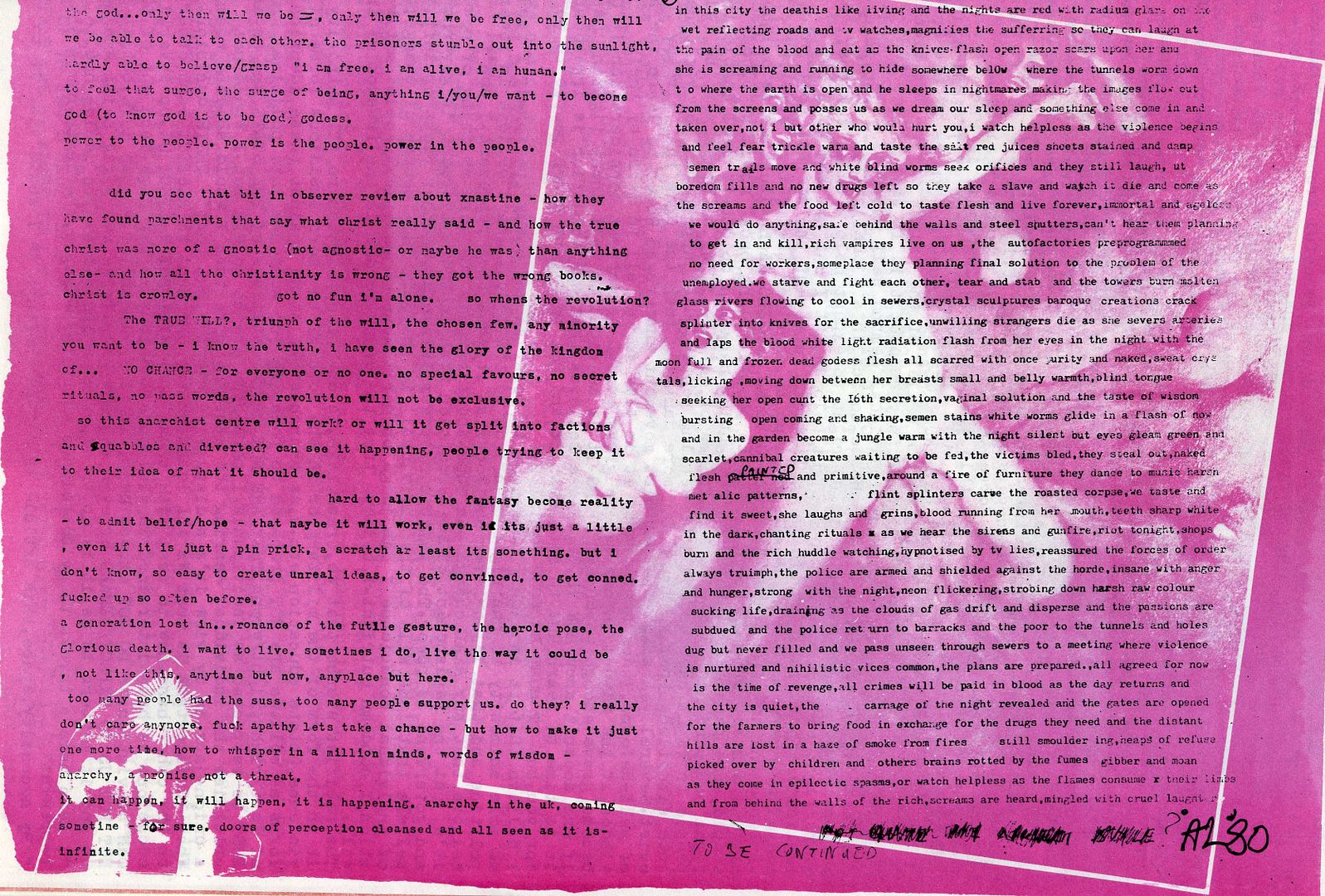
I then started visiting the Puppy Collective at weekends and became a regular contributor to the fanzine as AL Puppy.
To backtrack a little before moving on, Tony had started ‘Ripped and Torn’ while he was living in Glasgow. He then moved to London in early 1977 and lived in various squat in west London which later that year declared themselves the Independent Republic of Frestonia. In one of the squats, which had been a bookshop Tony found a collection of underground magazines – issues of OZ, Frendz and International Times from the late sixties and early seventies. At the time most punk fanzines were photocopied in black and white, but, when Kill Your Pet Puppy was being planned Tony was able to do a deal with Joly McPhie of Better Badges to use their colour photocopiers to print the new magazine. Joly had been part of the late sixties, early seventies west London counter-culture and encouraged Tony to make Kill Your Pet Puppy into a punk version of OZ or International Times.
1978 – 1979 also saw a skinhead revival and the skinheads began attacking punk squats and disrupting punk gigs, including Crass ones. Rock Against racism was very big in 1978 and overlapped with the Anti-Nazi League which was a Socialist Worker Party organisation. The National Front tried to counter this by setting up Rock Against Communism gigs which were popular with skinheads. In an attempt to distance themselves from what they saw as the politicisation of punk, Crass decided that they would become anarchists. This new stance was reflected in the lyrics of ‘White Punks on Hope’ written in early 1979.
Pogo on a Nazi, spit upon a Jew
Vicious mindless violence that offers nothing new
Left wing violence, right wing violence all seems much the same
Bully boys out fighting, it’s just the same old game
Boring fucking politics that’ll get us all shot
Left wing, right wing, you can stuff the lot
Keep your petty prejudice, I don’t see the point
Anarchy and freedom is what I want

This did not solve the problem of violence at their gigs. This led Leigh Kendall, an Australian anarchist, punk and member of the band Last Words, to write a short article in Kill Your Pet Puppy number one, titled ‘Peaceful Pro- Crass- tination- a critical look at Crass peaceful anarchy stance ’ commitment to peaceful anarchism in relation to violence at their gigs’. Crass then invited Leigh and Tony Drayton to discuss the problem- which they did. It turned out that Crass had very little knowledge of anarchism. Penny Rimbaud of Crass was later to say [in The Story of Crass by George Berger]
“In all honesty I wasn’t aware of anarchism until about year one into Crass …We had got a peace banner to tell people we weren’t interested in kicking shit, and we had put up the circled A banner as something to get the left and right off our backs. It was then that we started getting people asking what we meant by that. I realised that outside of my own libertarian stance, I didn’t know what the fuck it was about. It was then I started looking at what it actually meant in terms of its history. I hadn’t had much interest in it and I can’t say I have now to be honest”.
In 1984, Andy Palmer of Crass told Radio Free France
“There were both left wing and right wing influences who were trying to co-opt what we were trying saying, which is largely why we adopted the anarchy symbol. Then we came up against the established anarchists, and their establishment idea of what anarchy meant, and as far as we could see, putting anarchy and peace together was a complete contradiction to the idea of what they had of what anarchy was, which was chaos and no government, general violent revolution, which was the opposite of what we were trying to say. So we put the peace banner together with anarchy banner”.
Crass’ symbolic appropriation of ‘anarchy’ was already present at the very beginning of punk as Jon Savage explained several years later.
“There was a lot of talk about anarchy in the summer of 1976. John Lydon was working on a set of lyrics to one of Glen’s tunes which became ‘Anarchy in the UK’. Vivienne set about making a parallel item of clothing. The resulting ‘Anarchy’ shirt was a masterpiece. Taking a second-hand sixties shirt, Westwood would dye it in stripes, black, red, or brown., before stencilling on a slogan such as ‘Only Anarchist Are Pretty’ . The next stage was to stitch on more slogans, hand painted on rectangles of silk or muslin. These made explicit references to Anarchist heroes and to the events of 1968: ’Prenez vos desirs pour la realite’, ‘A bas le Coca Cola’”.
“The final touches were the most controversial. Small rectangular portraits of Karl Marx (from Chinatown) were placed on the side of the chest, and on the other, above the pocket or on the collar, was placed an (often inverted) swastika from the Second World War. To ensure that the message was received, the whole shirt was finished off with an armband which simply read ‘Chaos’. The intention was the group should not be politically explicit, but instead should be an explosion of contradictory, highly charged signs”.
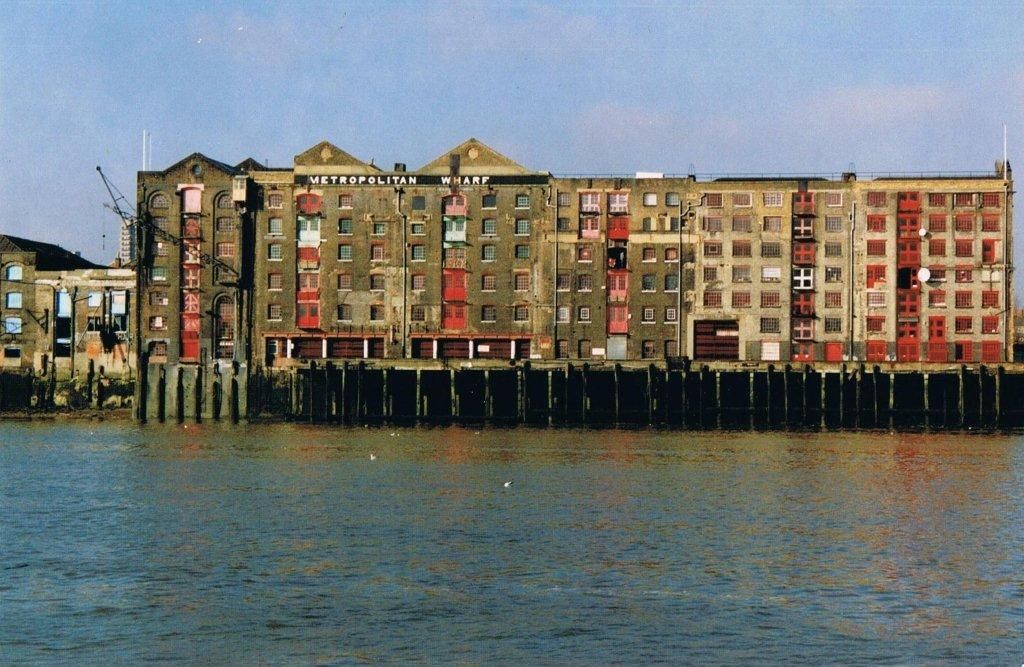
The Sex Pistols single ‘Anarchy in the UK’ was released in November 1976. The Crass and Poison Girls benefit single for what was to become the Wapping Autonomy Centre was released in May 1980 and raised £10,000. The money was used to convert a space in a Victorian warehouse beside the Thames at Wapping into a social centre. After discussion the more neutral ‘Autonomy Centre’ was chosen over ‘Anarchist Centre’ as its name. It opened in early 1981 but was a rented space without an entertainment licence or a drinks licence. The rent was £680 a quarter and by November 1981 the lack of committed support from the traditional anarchist community had created a financial crisis.
To bring in some cash, it was agreed to put on punk gigs on Sunday nights at the Autonomy Centre. Over the next three month these brought in £700 but as Albert Meltzer sadly observed
“With the punks’ money came the punks, and in the first week they had ripped up every single piece of furniture carefully bought, planned and fitted, down to the lavatory fittings that had been installed by Ronan Bennett from scratch, and defaced our own and everyone else’s wall for blocks around. In the excitement of the first gigs where they could do as they liked, they did as they liked and wrecked the place. Loss of club, loss of money, loss of effort. End of story”.
The problem was that the majority of the punks who came to the Sunday night gigs were teenagers, some as young as thirteen. For many of the audience and groups, the Autonomy Centre gigs were a continuation of gigs that had been put on in a squatted, derelict ‘Grimaldi’ church on the Pentonville Road through 1980 and 1981. These stopped after one of the homeless alcoholics who also used the church accidentally set fire to it.
While the end of the Wapping Autonomy Centre in February 1982 marked the end of one connection between anarchists and punks, a different connection soon emerged.
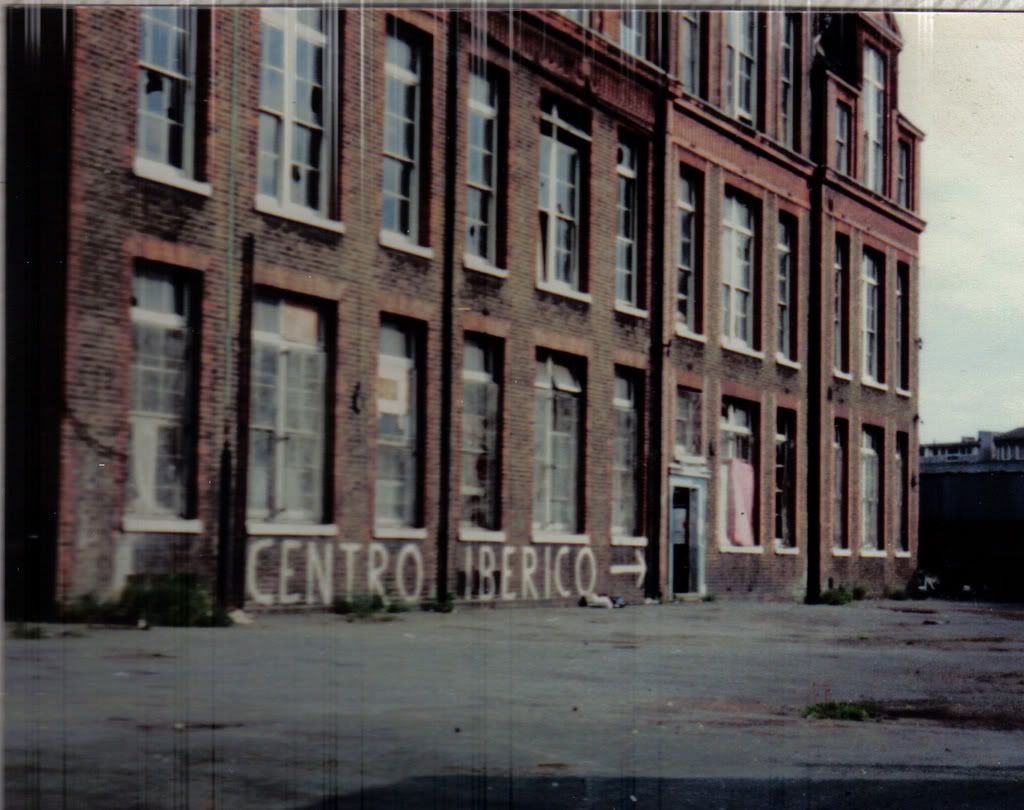
The new connection was with a group of Spanish anarchists who had squatted an abandoned school on the Harrow Road called the Centro Iberico. The Spanish anarchists lived in the classrooms upstairs and allowed us to convert a former assembly room downstairs into a performance space. A stage was built using old cookers from the kitchens covered with carpet retrieved from skips. Although the Centro was evicted at the end of 1982, for a few month during the spring and summer it was used once a week for anarchist punk gigs. After that a series of ’Anarchy Centres’ were squatted in north London over the next few years, one of which evolved into Molly’s Café on Upper Street in Islington.
A spin-off from these activities was the setting up of the Black Sheep Housing Co-op in Islington in 1982, which by 1983 had been given four derelict houses to convert by Islington Council. After the failure of a building co-op to convert the houses, we had to do the conversion work ourselves. This venture provided an alternative to squatting for co-op members over the next ten years, although many of the original Black Sheep went on to become ‘new age travellers’. I moved into one of the Black Sheep houses in 1983 while I was still working for London Rubber. Mark Wilson of the Mob, a well-known anarcho-punk group lived in the same house and in 1984 Mark asked me to take over the Mob’s record company called All the Madmen which I ran for the next couple of years and which I am still involved in a small way, thirty years on.
Politically, the most interesting actions that took place in in 1983 and 1984 were the Stop the City actions. Unfortunately, my partner Pinki who was involved in the planning and organisation of these protests died in 1996, but while we lived together she did pass on various snippets of information which I will now try to piece together. As soon as she was sixteen in 1978, Pinki left home to become a punk Squatter in London. Then in 1980 she returned home to Gloucestershire and became involved with Stroud CND. In late 1981, Stroud CND visited the newly established peace camp at Greenham Common. The others went home but Pinki stayed at Greenham on and off for the next three years. In 1982 she took part in a protest against the Falklands victory parade in London, which was organised by London Greenpeace.
In early 1983 Pinki was involved in the planning of the first Stop the City protest also organised by London Greenpeace where she was arrested and swiftly released since she was nine months pregnant. Her son Sky was born four days later. This became the first Stop The City which was held on 29th September 1983. Three more Stop The City actions followed in 1984.
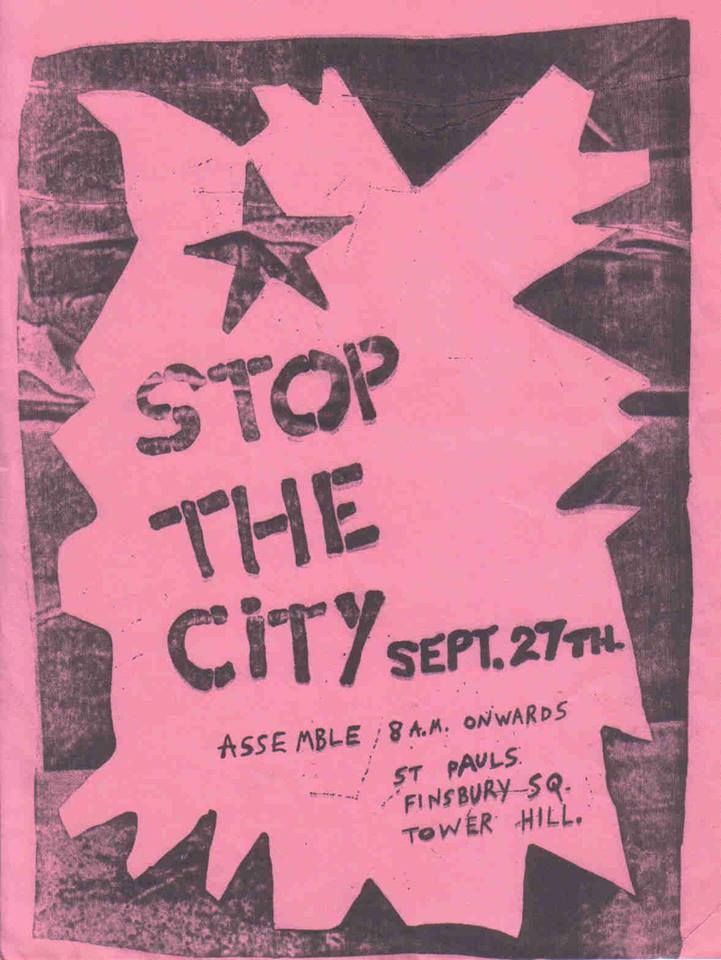
The full story of the Stop the City actions has yet to be written, but last year Rich Cross wrote about them for Freedom in September 2013.
Called on 29th September 1983, to coincide with the quarterly calculation of the City’s profits, protestors were encouraged to take part in a ‘carnival against war’ and deliver ‘a day of reckoning’ for the warmongers and racketeers of the Square Mile. Around 1500 anarchists, libertarians, punks and radical peace activists descended on the City to occupy buildings, block roads, stage actions and swarm through the streets.
Cumulatively these efforts were designed to snarl up the operation of the capital’s financial hub. In an analogue era, long before the City’s ‘Big Bang’, when files and paperwork still had to be physically couriered between companies, the impact of mobs of unruly demonstrators filling the City’s narrow streets could be dramatic. Estimates differed, but the occupation of corporate space interrupted scores of monetary transactions, and drove down the day’s profits. The cost to those demonstrating was significant too: more than 200 arrests at the first Stop The City; nearly 400 at the March 1984 event; and close to 500 in September 1984.
Support for Stop The City came from two principal directions: from elements within the radical wing of the nuclear disarmament movement (which had been looking for ways to generalise and extend action beyond military bases) and from within the ranks of anarcho-punk (a sub-culture eager to test out its collective political muscle). But the audacity of Stop The City struck a chord with activists and militants from many other movements and campaigns.
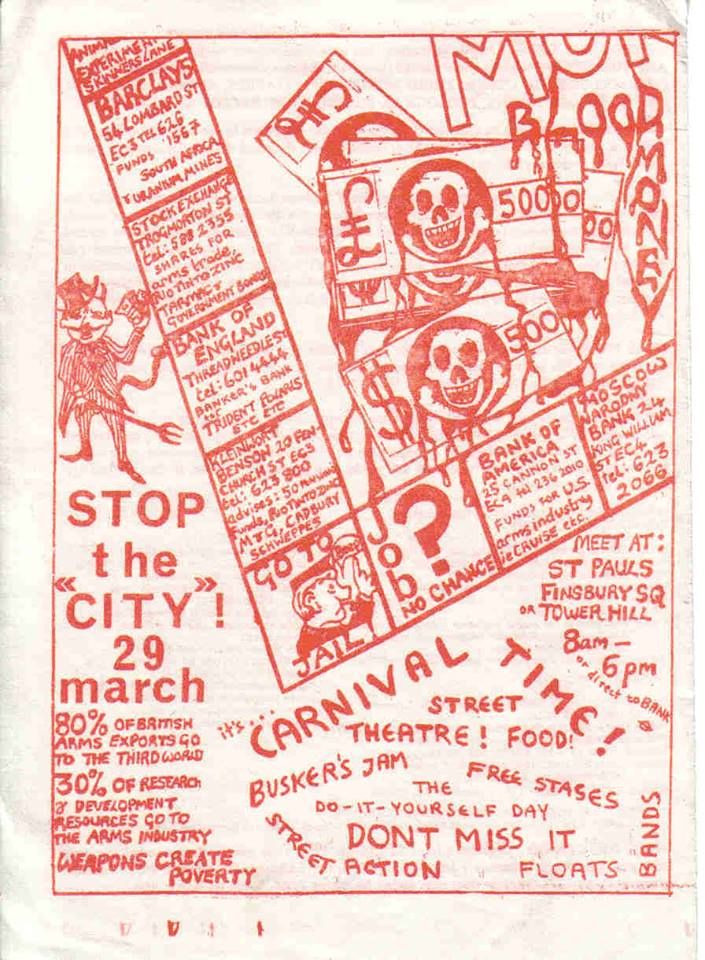
Pinki was arrested on the first Stop the City but released since she was nine months pregnant. Her son Sky was born four days later. She was arrested again at the second Stop the City and held overnight. A crèche had been arranged and fortunately Dave Morris took Sky home with him after it closed. Pinki was arrested again on the third Stop the City, but this time we were in a relationship so she arranged that I would look after Sky for the day. Over the next twelve years, apart from 1990 when I almost stood for election as an anti-Poll tax Green Party councillor in Hackney, Pinki was the activist of the family while I kept the home fire burning. Pinki’s last and twenty sixth arrest and was in June 1994 at a road protest in Bath.

Compared with the Stop the City actions, the Poll Tax riot on 31st March 1990 in Trafalgar Square was a mega-event. We weren’t there, but myself and Pinki had been present when an anti-Poll tax protest in Hackney turned into a minor riot a few weeks earlier. On a wet day in January 1990 the Livingston family set off from Hackney to Blackheath in south London. We were going to the launch of the English Anti-Poll Tax Campaign. Blackheath was chosen because of its link to the 1381 Poll Tax Uprising. The revolting Kentish peasants camped on Blackheath on 12th June 1381 before joining with the Essex peasants to occupy London the next day.
I don’t recall it being a very impressive event. There were a few banners, a few hundred political activists trying to sell each other their revolutionary tracts and perhaps some stalls. It did not seem much better organised than Stonehenge Campaign events we had attended a few years earlier.
We did pick up an anti-Poll Tax Green Party leaflet which inspired us to join the Party. I started going to meetings of the local Stoke Newington and Hackney North branch and put myself forward as candidate for the local elections due to be held later that year. Our ward was mainly made up of the huge Nightingale Estate plus our Estate and few surrounding streets. I went to Hackney library and checked the stats from the previous election- turnout on our ward was very low, less than 20%. I worked out that I only had to persuade a couple of hundred people who hadn’t bothered to vote before to vote for me as an anti-Poll tax candidate to win.
It seemed do-able, but just to make sure, I got in touch with the Hackney Tenants and Residents Association, based in the old Shoreditch Town Hall to see about setting up a local branch. The local community centre was on Brooke Road and was where our children went to playgroup. I went along one day to see about hiring a room in the community centre for a first meeting and to get some flyers printed. In a slightly surreal co-incidence the new community worker there was Ian Bone. Ian was very enthusiastic about the tenants group, but quickly headed me off before I started discussing politics by saying ’Of course, I am an old Labour Party man, myself’. This puzzled me at first, but then I realised that the rather thin partition walls in the community centre meant that our conversations would be public rather than private…
As it turned out, the Green Party decided to lead their local election campaign on the dangers of irradiated food rather than the Poll Tax and at the two tenants meetings I organised the problem of how to get rid of some squatters from our estate and how to get Hackney Council to carry out a long list of essential repairs were the main subjects discussed. No-one at the time seemed very bothered about the Poll Tax.
Meanwhile, Hackney Council had set 8th March 1990 as the date when they would vote on what level to set the Poll Tax. As a Labour controlled council, it was unlikely (impossible) that they would refuse to impose the tax. Even if they did, I found that central government would then appoint an Auditor to set a Poll Tax rate for Hackney anyway. As the date grew closer, and as people in England started to catch up with Scotland, where the tax had been brought in the year before, things got more interesting.
I went to an anti-poll tax meeting on Southwold Estate, but although it had been organised by one of the tenants – a young woman- she was flanked by four non-local Militant members. This annoyed me, since it looked as if they were trying to take over our Hackney campaign. I asked if Militant were working with the Socialist Workers Party who blitzing Hackney with posters stating ‘HACKNEY POLL TAX £475’. This caused consternation and the muffled reply “No we aren’t” but fortunately for the Militants, one of the Southwold tenants then accused me of trying to split the campaign by asking the question…
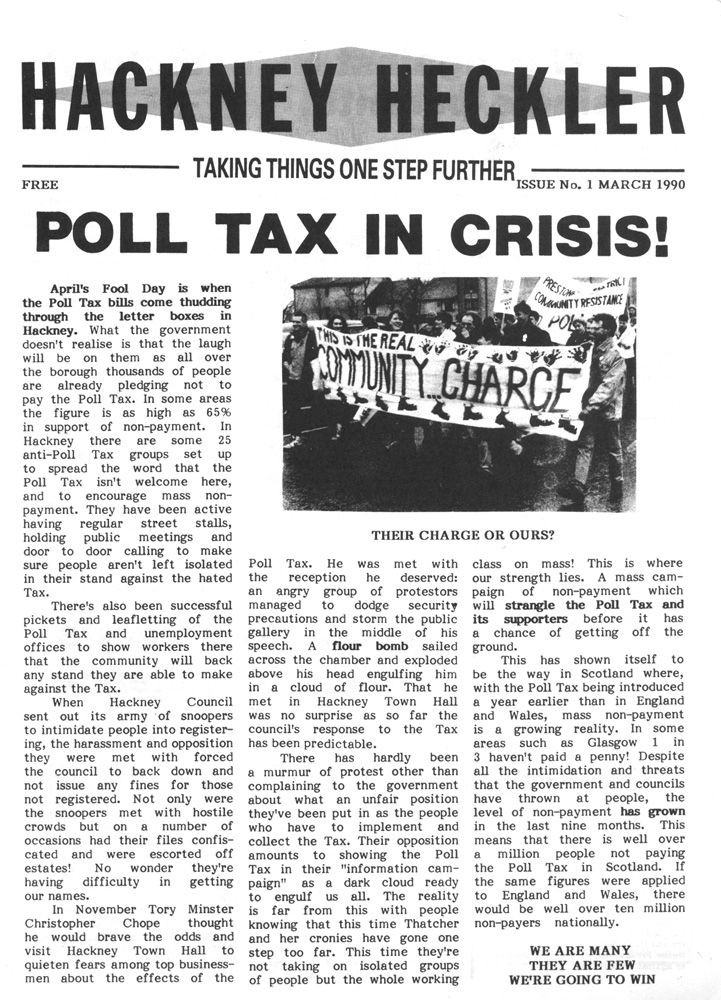
Then came the day… On 8th March the council met to set the poll tax rate for Hackney in a boarded up town hall surrounded by a wall of police confronting an increasingly agitated 1000 strong crowd. Three days earlier, Harringey had set their rate and there had been a minor riot. Now everyone was expecting a riot in Hackney. The whole scene was unreal. It didn’t look or feel like every day Hackney at all. I half expected helicopters to come in and rescue the councillors like what happened when Saigon finally fell to the Vietcong in 1974.
I had, rather naively, planned to give an election speech to the crowd so was wearing my wedding suit. There was a BBC London film crew there and I was chatting to them when they suddenly got busy, anticipating trouble. So I moved on to the steps in front of the town hall to get my speech in before the trouble started. I managed to say “If you want to get rid of the Poll Tax, don’t get mad get even and vote Green” before the police suddenly moved forward from behind me to push the crowd away from the town hall. The only response I had from my election speech was a young punk woman in the crowd shouting back at me “It is too late for that now”.
I then went home then but my wife stayed on to report later that a riot had broken out. McDonalds burger bar was smashed up and Paddy Ashdown, who had been giving a speech in the Assembly Rooms behind the town hall, had his car attacked by the crowd and thirty eight people were arrested. One of our punk friends told us later that he had got close enough to Paddy Ashdown to give him a punch…
Compared with the major Poll tax riot which took place in and around Trafalgar Square on the 31st March when there were three hundred and fifty arrests, what happened in Hackney was a minor affair. However, not wanting to be arrested for giving my speech in Hackney, beforehand I had contacted the local police, the council, several UK and foreign journalists and even Paddy Ashdown’s office. All the people I spoke to realised that there was going to be trouble, but seemed helpless before the rapid movement of events. That the massive 31st March Poll Tax rally would lead to a major riot now seemed a certainty. An unexpected outcome of the Trafalgar Square riot was the enforced resignation of Margaret Thatcher in November 1990.
My enduring memory is of the few moments that I was stood between the police and the protestors, trying to give my political speech. The sheer intensity of the anger of the crowd was like a physical force, their rage, built up over eleven years of Thatcher governments waging class war was like a blazing furnace. It was not what I had expected at all. Like the young punk woman said “it was too late” for my ‘vote Green’ pitch. Way too late. The only coherent thought I can recall from the experience was ‘Fucking hell, there is going to be a revolution’.
Reflecting on the dramatic events of 1990, it is possible to see in the very different reactions to the Poll Tax north and south of the border the first signs that Scotland and the rest of the UK were beginning to move apart politically. In Scotland the economic hammer blows of Thatcherism re-forged a powerful sense of Scotland as a civil society. Across most of England, the same hammer blows fractured the post-war consensus and fragmented civil society. In Scotland, the Poll Tax gave rise to a popular movement of collective resistance which also focused Scottish civil society on the need for constitutional change. This led to the creation of a devolved Scottish Parliament in 1999. In England the Poll Tax led to riots.
A key theme of the Scottish Enlightenment was the idea of a ‘civil society’ existing between individuals and families and the state. If there had still been a Scottish state with Edinburgh as its political centre, this idea might not have arisen. Scottish intellectuals would, as members of a privileged elite, have been part of this Scottish state. But with the new Union state of Great Britain centred on London, the dispossessed Scottish professors, lawyers and ministers had to re-invent themselves as members of their own stateless civil society.
Since they viewed the new Union state as a continuation of the English state English intellectuals did not face this problem so had little interest in ‘Scotch philosophy’. The Scottish Enlightenment was more favourably received in France and Germany. Immanuel Kant claimed that David Hume ‘roused me from my dogmatic slumber’. Georg Hegel was another German philosopher who was influenced by Scottish Enlightenment thought. Hegel, however, developed his political ‘Philosophy of Right’, published in 1821, after the French Revolution and the Napoleonic wars. In Hegel’s version, civil society emerged out the disintegration of the family as the focus of ethical life and in turn a rational state will emerge out of civil society as the ‘actuality of the ethical idea’.
What Hegel hoped was that Prussia would be able to modernise and become a rational state without having to undergo a bloody revolution. But by the time he wrote an essay on the English (that is British) Reform Bill just before his death in 1831, Hegel was less optimistic. He feared that the forces unleashed by industrial capitalism would lead to revolution rather than reform in Britain.
Hegel’s fear reminds me of a question Tony Drayton asked one of the veteran Spanish anarchists at the Centro Iberico in 1982. Tony asked him “How did you manage to have an anarchist revolution in 1936?”. The reply was “Everyone was an anarchist”. Hegel also once said that what is rational becomes real and what is real becomes rational. It is forty years since I became a ‘self-confessed anarchist’. Over those years I have had plenty of time to change my mind. But I still believe that of all the varieties of political theories and practices, anarchism is the most rational and hence most real and so I look forward to the day when everyone is an anarchist.
Al Puppy – March 2014
Read more on the Wapping Autonomy Centre and hear downloads from bands on this KYPP post HERE
See the full set of photographs from the Wapping Autonomy Centre HERE
See the full set of photographs from the Centro Ibrico HERE

AL Puppy • Post Author •
March 11, 2014 at 11:18 pmSome brilliant pics and images here which illustrate my words very effectively. Thanks Penguin and Chris XXX
Kropotkin
March 12, 2014 at 5:16 pmAwesome, thanks for sharing all that.
120 Loop
March 20, 2014 at 11:35 pmgood job! do you see parallels between stop the city and the weatherman’s 1969 “days of rage”-
AL Puppy • Post Author •
March 21, 2014 at 6:14 pm120 Loop – possibly, but I had to look up the 1969 ‘Days of Rage’ – so not a question I had considered until now. I found this on wiki and will see what else I can dig up. http://en.wikipedia.org/wiki/Days_of_Rage
John Eden
March 27, 2014 at 10:20 amWapping Autonomy Centre gets a mention in Rob Dellar’s new book “Splitting in Two: Mad Pride and Punk Rock Oblivion”
http://unkant.com/index.php?option=com_content&view=article&id=111:rob-dellar-splitting-in-two-mad-pride-and-punk-rock-oblivion&catid=84&Itemid=562
(as do Brougham Road, various squatters, and a bunch of other interesting material.)
JC
March 30, 2014 at 10:42 pm“In an attempt to distance themselves from what they saw as the politicisation of punk, Crass decided that they would become anarchists. This new stance was reflected in the lyrics of ‘White Punks on Hope’ written in early 1979”
This is misleading, Crass started as a 2 piece band, Penny Rimbaud was already living in a commune (that he founded) and writing his book Reality Asylum. They produced “So What?” and “Do They Owe Us A Living?” as a drum-and-vocal duo. Listen to the lyrics. They was living the anarchist life style long before they became a band, they wasn’t just talking or singing about it they was actually doing it.
m4rkland
April 6, 2014 at 1:12 pminteresting and enjoyable piece! Thanks.
Sparky
April 7, 2014 at 2:59 pm@ JC: I would imagine most on here are familiar with the origins of Crass.
“They was living the anarchist life style long before they became a band, they wasn’t just talking or singing about it they was actually doing it.”
Anarchism is a revolutionary movement going back to the mid 1800s.
Crass’ ideology – by their own admission – was one based on ‘personal liberation’ rather than revolutionary struggle. Also, while I’m sure living in a commune in leafy Epping was lovely it is hardly a social model that can be applied to society at large.
As such, the comments in this piece are accurate.
Sparky
April 7, 2014 at 3:00 pmFantastic piece by the way, Al.
joggon
April 21, 2014 at 7:30 pmInteresting read on a long dull Easter Monday, so is Cameron and his Bullingdon club chums actually anarchists?
He’s saying he’s a Christian now, wtf? Wonder what Jesus would think of that?
How many Stop the city demos were there?
I think it may have been the 3rd one I spent hours trying to get to, kept seeing men in suits heading away from the city covered in flour, was the 3rd one when the cops just started to ‘kettle’ groups of people? Managed to get into the square mile eventually.
Gutted I missed the first ones, they were part of the reason I moved to London for a while.
I also missed the now infamous poll tax riot, although it was great to see it on live TV showing what was happening, next day Strangeway Prison went off, what a time, don’t know if we’ll see similar on that scale in London again?